Chengzu Li
11Plus-Bench: Demystifying Multimodal LLM Spatial Reasoning with Cognitive-Inspired Analysis
Aug 27, 2025Abstract:For human cognitive process, spatial reasoning and perception are closely entangled, yet the nature of this interplay remains underexplored in the evaluation of multimodal large language models (MLLMs). While recent MLLM advancements show impressive performance on reasoning, their capacity for human-like spatial cognition remains an open question. In this work, we introduce a systematic evaluation framework to assess the spatial reasoning abilities of state-of-the-art MLLMs relative to human performance. Central to our work is 11Plus-Bench, a high-quality benchmark derived from realistic standardized spatial aptitude tests. 11Plus-Bench also features fine-grained expert annotations of both perceptual complexity and reasoning process, enabling detailed instance-level analysis of model behavior. Through extensive experiments across 14 MLLMs and human evaluation, we find that current MLLMs exhibit early signs of spatial cognition. Despite a large performance gap compared to humans, MLLMs' cognitive profiles resemble those of humans in that cognitive effort correlates strongly with reasoning-related complexity. However, instance-level performance in MLLMs remains largely random, whereas human correctness is highly predictable and shaped by abstract pattern complexity. These findings highlight both emerging capabilities and limitations in current MLLMs' spatial reasoning capabilities and provide actionable insights for advancing model design.
Reinforcement Learning for Better Verbalized Confidence in Long-Form Generation
May 29, 2025



Abstract:Hallucination remains a major challenge for the safe and trustworthy deployment of large language models (LLMs) in factual content generation. Prior work has explored confidence estimation as an effective approach to hallucination detection, but often relies on post-hoc self-consistency methods that require computationally expensive sampling. Verbalized confidence offers a more efficient alternative, but existing approaches are largely limited to short-form question answering (QA) tasks and do not generalize well to open-ended generation. In this paper, we propose LoVeC (Long-form Verbalized Confidence), an on-the-fly verbalized confidence estimation method for long-form generation. Specifically, we use reinforcement learning (RL) to train LLMs to append numerical confidence scores to each generated statement, serving as a direct and interpretable signal of the factuality of generation. Our experiments consider both on-policy and off-policy RL methods, including DPO, ORPO, and GRPO, to enhance the model calibration. We introduce two novel evaluation settings, free-form tagging and iterative tagging, to assess different verbalized confidence estimation methods. Experiments on three long-form QA datasets show that our RL-trained models achieve better calibration and generalize robustly across domains. Also, our method is highly efficient, as it only requires adding a few tokens to the output being decoded.
Enriching Patent Claim Generation with European Patent Dataset
May 18, 2025Abstract:Drafting patent claims is time-intensive, costly, and requires professional skill. Therefore, researchers have investigated large language models (LLMs) to assist inventors in writing claims. However, existing work has largely relied on datasets from the United States Patent and Trademark Office (USPTO). To enlarge research scope regarding various jurisdictions, drafting conventions, and legal standards, we introduce EPD, a European patent dataset. EPD presents rich textual data and structured metadata to support multiple patent-related tasks, including claim generation. This dataset enriches the field in three critical aspects: (1) Jurisdictional diversity: Patents from different offices vary in legal and drafting conventions. EPD fills a critical gap by providing a benchmark for European patents to enable more comprehensive evaluation. (2) Quality improvement: EPD offers high-quality granted patents with finalized and legally approved texts, whereas others consist of patent applications that are unexamined or provisional. Experiments show that LLMs fine-tuned on EPD significantly outperform those trained on previous datasets and even GPT-4o in claim quality and cross-domain generalization. (3) Real-world simulation: We propose a difficult subset of EPD to better reflect real-world challenges of claim generation. Results reveal that all tested LLMs perform substantially worse on these challenging samples, which highlights the need for future research.
Visual Planning: Let's Think Only with Images
May 16, 2025Abstract:Recent advancements in Large Language Models (LLMs) and their multimodal extensions (MLLMs) have substantially enhanced machine reasoning across diverse tasks. However, these models predominantly rely on pure text as the medium for both expressing and structuring reasoning, even when visual information is present. In this work, we argue that language may not always be the most natural or effective modality for reasoning, particularly in tasks involving spatial and geometrical information. Motivated by this, we propose a new paradigm, Visual Planning, which enables planning through purely visual representations, independent of text. In this paradigm, planning is executed via sequences of images that encode step-by-step inference in the visual domain, akin to how humans sketch or visualize future actions. We introduce a novel reinforcement learning framework, Visual Planning via Reinforcement Learning (VPRL), empowered by GRPO for post-training large vision models, leading to substantial improvements in planning in a selection of representative visual navigation tasks, FrozenLake, Maze, and MiniBehavior. Our visual planning paradigm outperforms all other planning variants that conduct reasoning in the text-only space. Our results establish Visual Planning as a viable and promising alternative to language-based reasoning, opening new avenues for tasks that benefit from intuitive, image-based inference.
A Call for New Recipes to Enhance Spatial Reasoning in MLLMs
Apr 21, 2025Abstract:Multimodal Large Language Models (MLLMs) have demonstrated impressive performance in general vision-language tasks. However, recent studies have exposed critical limitations in their spatial reasoning capabilities. This deficiency in spatial reasoning significantly constrains MLLMs' ability to interact effectively with the physical world, thereby limiting their broader applications. We argue that spatial reasoning capabilities will not naturally emerge from merely scaling existing architectures and training methodologies. Instead, this challenge demands dedicated attention to fundamental modifications in the current MLLM development approach. In this position paper, we first establish a comprehensive framework for spatial reasoning within the context of MLLMs. We then elaborate on its pivotal role in real-world applications. Through systematic analysis, we examine how individual components of the current methodology-from training data to reasoning mechanisms-influence spatial reasoning capabilities. This examination reveals critical limitations while simultaneously identifying promising avenues for advancement. Our work aims to direct the AI research community's attention toward these crucial yet underexplored aspects. By highlighting these challenges and opportunities, we seek to catalyze progress toward achieving human-like spatial reasoning capabilities in MLLMs.
Imagine while Reasoning in Space: Multimodal Visualization-of-Thought
Jan 13, 2025



Abstract:Chain-of-Thought (CoT) prompting has proven highly effective for enhancing complex reasoning in Large Language Models (LLMs) and Multimodal Large Language Models (MLLMs). Yet, it struggles in complex spatial reasoning tasks. Nonetheless, human cognition extends beyond language alone, enabling the remarkable capability to think in both words and images. Inspired by this mechanism, we propose a new reasoning paradigm, Multimodal Visualization-of-Thought (MVoT). It enables visual thinking in MLLMs by generating image visualizations of their reasoning traces. To ensure high-quality visualization, we introduce token discrepancy loss into autoregressive MLLMs. This innovation significantly improves both visual coherence and fidelity. We validate this approach through several dynamic spatial reasoning tasks. Experimental results reveal that MVoT demonstrates competitive performance across tasks. Moreover, it exhibits robust and reliable improvements in the most challenging scenarios where CoT fails. Ultimately, MVoT establishes new possibilities for complex reasoning tasks where visual thinking can effectively complement verbal reasoning.
TopViewRS: Vision-Language Models as Top-View Spatial Reasoners
Jun 04, 2024



Abstract:Top-view perspective denotes a typical way in which humans read and reason over different types of maps, and it is vital for localization and navigation of humans as well as of `non-human' agents, such as the ones backed by large Vision-Language Models (VLMs). Nonetheless, spatial reasoning capabilities of modern VLMs remain unattested and underexplored. In this work, we thus study their capability to understand and reason over spatial relations from the top view. The focus on top view also enables controlled evaluations at different granularity of spatial reasoning; we clearly disentangle different abilities (e.g., recognizing particular objects versus understanding their relative positions). We introduce the TopViewRS (Top-View Reasoning in Space) dataset, consisting of 11,384 multiple-choice questions with either realistic or semantic top-view map as visual input. We then use it to study and evaluate VLMs across 4 perception and reasoning tasks with different levels of complexity. Evaluation of 10 representative open- and closed-source VLMs reveals the gap of more than 50% compared to average human performance, and it is even lower than the random baseline in some cases. Although additional experiments show that Chain-of-Thought reasoning can boost model capabilities by 5.82% on average, the overall performance of VLMs remains limited. Our findings underscore the critical need for enhanced model capability in top-view spatial reasoning and set a foundation for further research towards human-level proficiency of VLMs in real-world multimodal tasks.
Semantic Map-based Generation of Navigation Instructions
Mar 28, 2024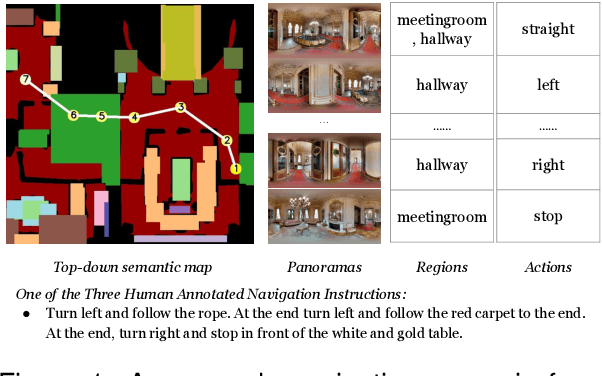

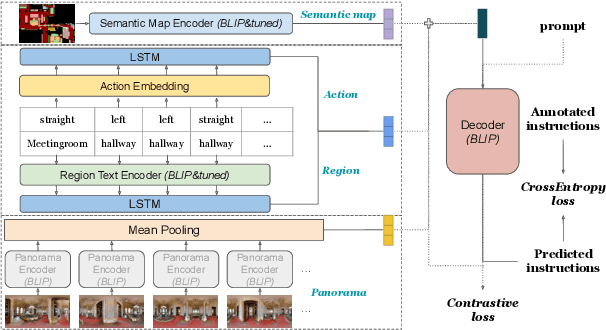
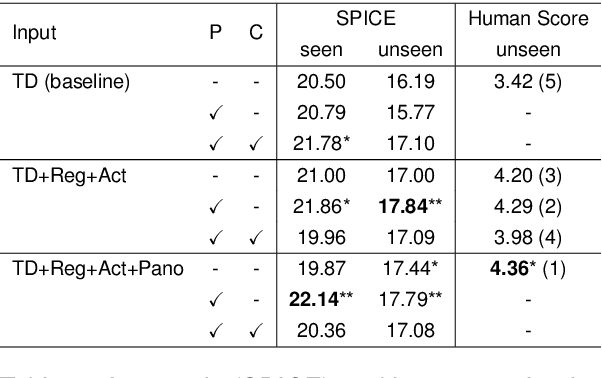
Abstract:We are interested in the generation of navigation instructions, either in their own right or as training material for robotic navigation task. In this paper, we propose a new approach to navigation instruction generation by framing the problem as an image captioning task using semantic maps as visual input. Conventional approaches employ a sequence of panorama images to generate navigation instructions. Semantic maps abstract away from visual details and fuse the information in multiple panorama images into a single top-down representation, thereby reducing computational complexity to process the input. We present a benchmark dataset for instruction generation using semantic maps, propose an initial model and ask human subjects to manually assess the quality of generated instructions. Our initial investigations show promise in using semantic maps for instruction generation instead of a sequence of panorama images, but there is vast scope for improvement. We release the code for data preparation and model training at https://github.com/chengzu-li/VLGen.
On Task Performance and Model Calibration with Supervised and Self-Ensembled In-Context Learning
Dec 22, 2023Abstract:Following the standard supervised fine-tuning (SFT) paradigm, in-context learning (ICL) has become an efficient approach propelled by the recent advancements in large language models (LLMs), yielding promising performance across various tasks in few-shot data setups. However, both paradigms are prone to suffer from the critical problem of overconfidence (i.e., miscalibration), especially in such limited data setups. In this work, we deliver an in-depth analysis of the behavior across different choices of learning methods from the perspective of both performance and calibration, as well as their interplay. Through extensive controlled experiments, we find that simultaneous gains for both task performance and calibration are difficult to achieve, and the problem of miscalibration exists across all learning methods in low-resource scenarios. To address this challenging trade-off between performance and calibration, we then investigate the potential of self-ensembling techniques applied at different modeling stages (e.g., variations of in-context examples or variations in prompts or different ensembling strategies). We justify the feasibility of self-ensembling on SFT in addition to ICL, to make the predictions more calibrated and have comparable or even better performance. Our work sheds light on which learning paradigm to choose and how to enhance both task performance and calibration of LLMs.
Generating Data for Symbolic Language with Large Language Models
May 23, 2023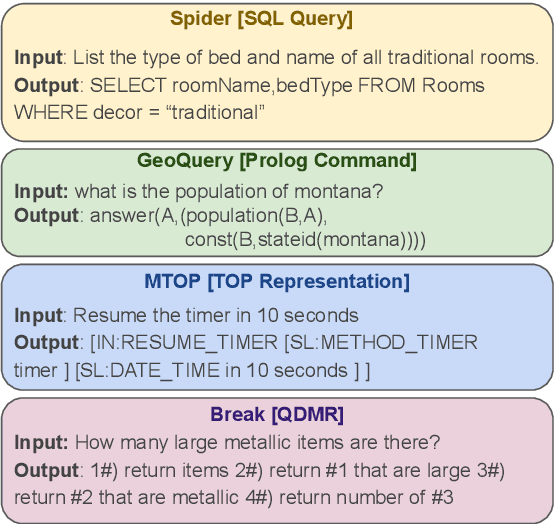
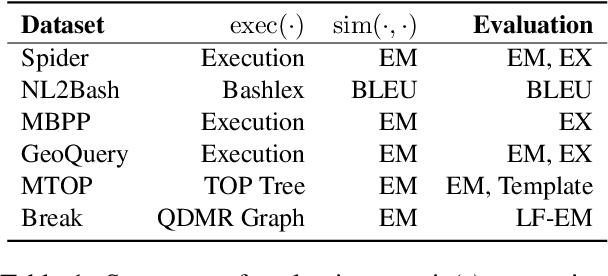
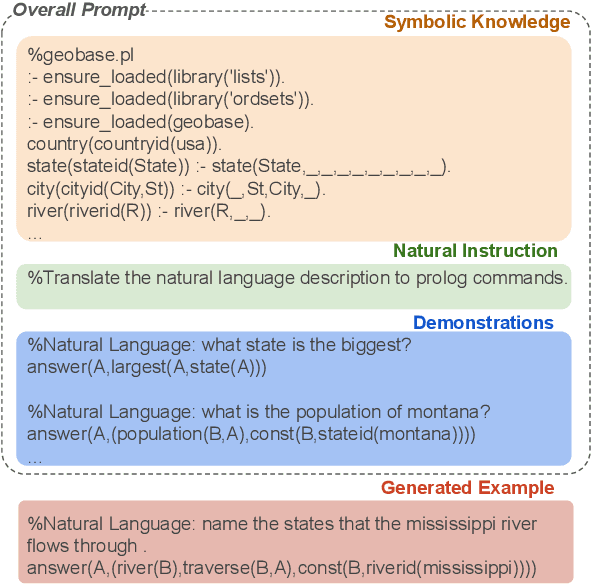
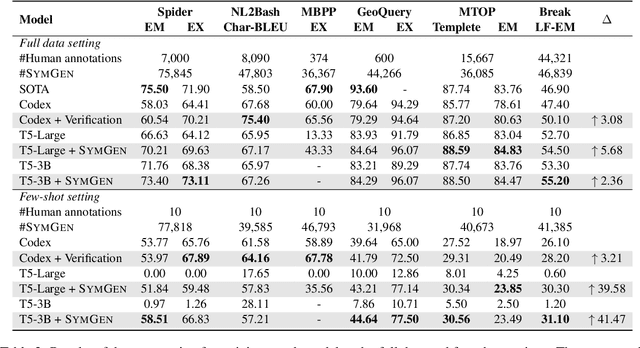
Abstract:While large language models (LLMs) bring not only performance but also complexity, recent work has started to turn LLMs into data generators rather than task inferencers, where another affordable task model is trained for efficient deployment and inference. However, such an approach has primarily been applied to natural language tasks and has not yet been explored for symbolic language tasks with complex structured outputs (e.g., semantic parsing and code generation). In this paper, we propose SymGen which utilizes LLMs for generating various annotation-expensive symbolic language data. SymGen consists of an informative prompt to steer generation and an agreement-based verifier to improve data correctness. We conduct extensive experiments on six symbolic language tasks across various settings. Compared with the LLMs, we demonstrate the 1\%-sized task model can achieve comparable or better performance, largely cutting inference and deployment costs. We also show that generated data with only a few human demonstrations can be as effective as over 10 times the amount of human-annotated data when training the task model, saving a considerable amount of annotation effort. SymGen sheds new light on data generation for complex tasks, and we release the code at \href{https://github.com/HKUNLP/SymGen}{https://github.com/HKUNLP/SymGen}.
 Add to Chrome
Add to Chrome Add to Firefox
Add to Firefox Add to Edge
Add to Edge